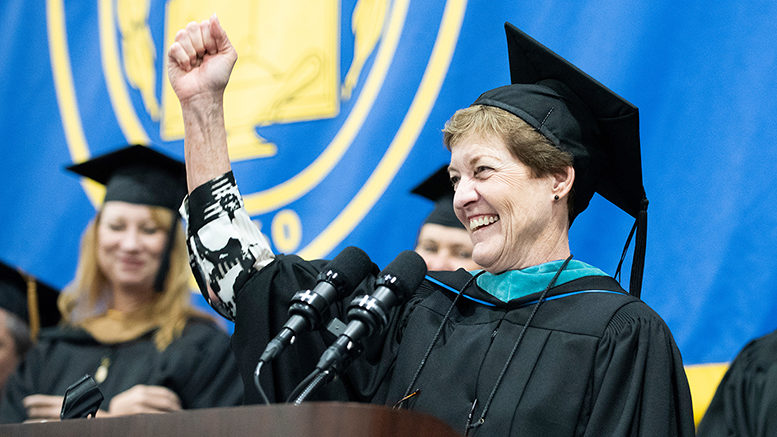When it comes to fundraising for community colleges, Ann Decker has some advice: listen to the potential donor and be transparent.
It’s on that bedrock strategy that the Indian River State College (IRSC) Foundation in Florida has increased its assets four-fold to $200 million over Decker’s 14-year career at the college.
“It is very easy to tell a potential donor what you want, but it is far more important to listen to what they want and where they want to put their hard-earned dollars, and see if you can marry it to the needs of the institution,” said Decker, who retired last month as executive director of the foundation.
On several occasions, Decker has had to turn down potential donation offers because they didn’t align with the college’s goals. One would-be donor wanted to fund an archeology degree with a pretty sizeable donation.
“I said ‘We are not going to have an archeology degree because we have no workforce need with an archeology degree in the area,'” Decker recalled telling him, and she even suggested that the donation may be better suited for a university or museum.
Change right away
Most donors want to see an immediate impact in the community through their gift, Decker said. Community colleges are among institutions where that can happen, even with a small donation. The national attention on college costs, student debt and other challenges that many two-year college students face — such as food and housing insecurity — has prompted more donors to look at community colleges.
“Donors are much more interested in providing scholarships here and supporting community colleges because those individuals who attend the community colleges stay in the community,” Decker said. “And they (donors) want to help the local community, whether it’s your firefighter, nurse, automotive mechanic or air-conditioning technician. These are all people who live next door, they are your neighbors and your employees. And if they can help them to further and better their lives, it just highlights all the good work that community colleges do across the nation.”
Sometimes a potential donor may express they want to help, but they can only offer a small amount, Decker said. She explains to them that even a small donation can go a long way at a community college and help almost immediately.
“If they are going to give $1,000 to Columbia University, it’s not going to go very far,” she said. “They give $1,000 to a community college, that amount takes a student through just about three-quarters of a semester with their tuition, certainly at our school. That’s huge. That might buy half a class at a major university.”
The Covid pause
The Covid pandemic hasn’t had a significant effect at IRSC in terms of fundraising. A few donors who regularly supported student scholarships and other efforts did briefly pause to determine if they would continue to do so or perhaps direct their money toward helping with food and housing for students, said Decker, who at the time was working to secure about $750,000 to $1 million in donations.
“What they did was step up their generosity to support those food insecurities, housing insecurities and in addition made their commitments to education,” she said. “I had some months of ‘Oh, dear, I wonder if these educational dollars are going to come through. And they did.”
A memorable story
Decker can tell many stories about donations to the college. But one that stuck out in particular during this interview was a woman who moved to the area after she retired. Decker met her 10 years ago when the retiree was briefly involved in the college’s lifelong learning program. The retired farmer never had a chance to go to college and wanted to start a student scholarship for women using a modest IRA.
“I want you to know that if I die tomorrow, it’s not going to be much money,” Decker recalled her saying. “I told her that no matter what the amount, it’s more than a student would have had a day before.”
The woman later became ill and passed away, unbeknownst to Decker. The donor’s sister contacted Decker and said a financial institution holding the IRA funds would soon forward a check for $660,000.
“For the rest of the days of this college, that fund is going to support numerous female students who are attending Indian River State College,” Decker said. “That’s transformational. Absolutely transformational.”
A percentage, please
There has been a slight uptick in donors including IRSC in their estate plans, Decker said. Rather than a set dollar amount, Decker suggests leaving a percentage. On occasion when a college is listed as a beneficiary for an amount, the funds may all be disbursed by the time it gets to the college. Setting a percentage ensures all the beneficiaries get a share — just make sure it adds up to 100%.
“We had a gift a couple of years ago where we received 7.5% in someone’s will. I was thrilled. It was $467,000. I’ll take that all day long,” Decker said.
She reflected for a moment on that gift and others as well as on her career.
“Being able to connect the dreams and passions of donors with the dreams and passions of students, faculty and the college, it doesn’t get any better than that,” she said. “Every day, when generosity speaks first, it just doesn’t get any better than that.”

